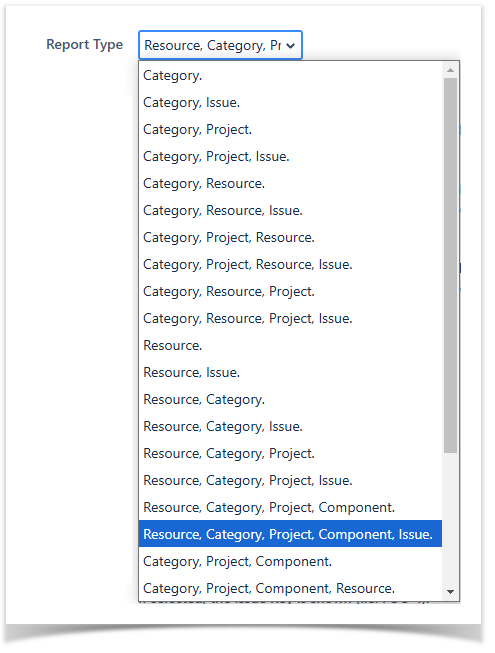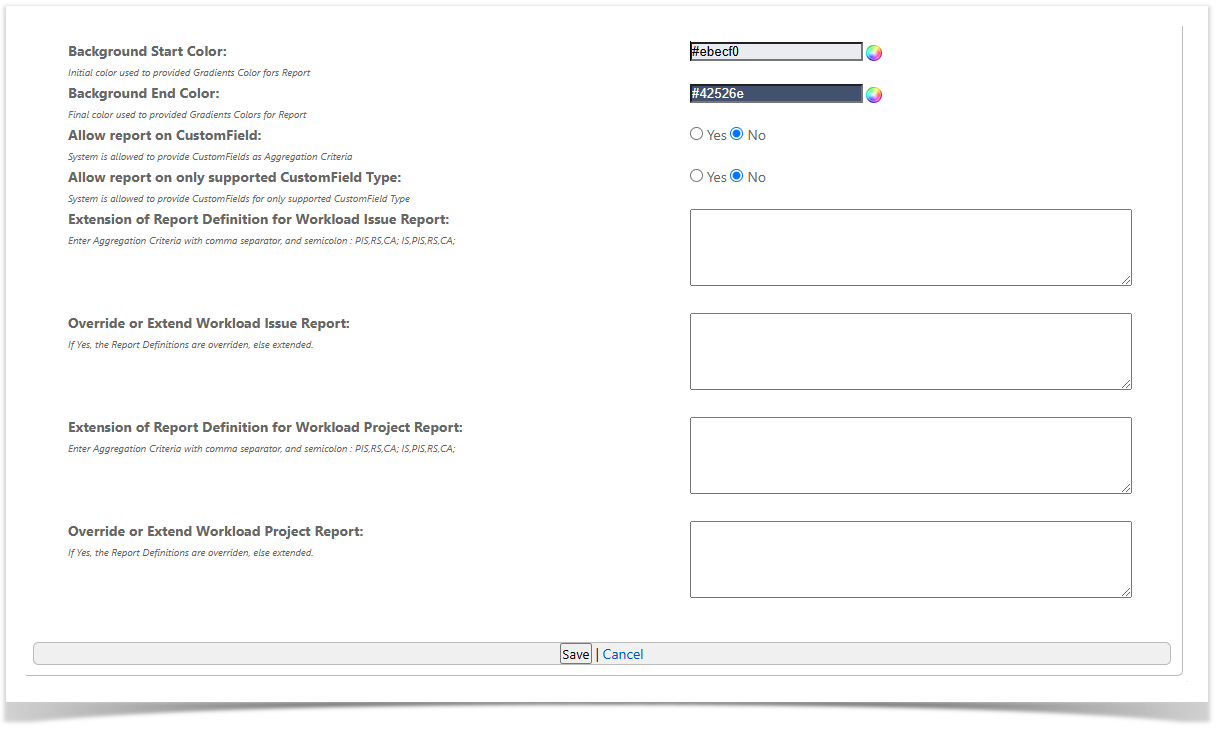Overview
Worklog Reports are all based on the same mechanism of aggregation. You will have to defined :
- the Report Type (List of Aggregation Criteria )
- the Criteria to use to filter Worklogs
Note that filtering will be applied only the filter Criteria is also an Aggregation Criteria - and which view to use
How worklogs are displayed
Different views are predefined :
- hierarchicView : Providing a Hierarchical display of aggregated data with expand and collapse features.
- flatView : Providing a classical display.
- excelView : Similar as flatView but without graphical rendering, used to export to Excel (undecorated HTML file).
In such cases, the default behavior of the Flat View is to display the values associated to leaf of the aggregation tree, assuming that each parent node is just a calculation of leaf's values.
But, the both (Issues and Sub-Tasks) are able to have logged Work, and then the value displayed in Flat View is only the Sub-Task's Spent Time.
To avoid to display only the Sub-Task's Spent Time and be able to see Issue's Spent Time, a new parameter has been introduced in Reports : the Flattened Level (let me know if you find a best term !).
The Flattened Level expressed the depth of node to flat when displaying the Flat View.
By default, all nodes are flattened. For example, if your report provides an aggregation based on :
- Category
- Project
- Issue
and the displayed Issues have sub-task, you will be able to force the view to flat node only on the 3 first nodes.
Hopping that this explanation is comprehensive.
How Worklogs are filtered
Each report is built with a filtered list of Worklogs.
The filter is possible with below criteria.
| Criteria | Type | Description |
|---|---|---|
| Start Date (1) | Absolute or Relative Date | Filtered Worklog have to be equal or after this date |
| End Date (1) | Absolute or Relative Date | Filtered Worklog have to be equal or before this date |
| JQL Filter (2)(4) | Integer | JQL Filter identified by its ID. |
| Category (2) | Integer | Project Category Id. to use in filtering |
| Project (2) | Integer | Project Id. to use in filtering |
| Developer (2)(3) | User or Group Name | Developer (Worker or author) having entered the Worklog |
- (1) Date Criteria support Relative Dates.
- (2) At least one of this criteria have to be selected. Selected values have to be valid for Category and Project.
- (3) If a Group is specified, the filter will take in account each Group's members.
- (4) Available since version xxx.1.56 ...
- Is the current user allowed to browse the Project (BROWSE_PROJECT Permission)
- Is the current user allowed to browse the Issue (Issue Securities levels)
- Is the current user allowed to browse the Worklog (BROWSE_WORKLOGS Permission)
Relative Date Operations
Supported Relative Date Operations
Date criteria may be filled with a relative Date format. The format follows below codification :
| Code | Value Description |
|---|---|
| NOW | Today (Current Date and Time) |
| DATE | Date passed in parameter |
| BOW | Begin Of Week |
| EOW | End Of Week |
| BOM | Begin Of Month |
| EOM | End Of Month |
| BOQ | Begin Of Quarter |
| EOQ | End Of Quarter |
| BOS | Begin Of Semester |
| EOS | End Of Semester |
| BOY | Begin Of Year |
| EOY | End Of Year |
| +1D | Day |
| +1B | Business Day |
| +1W | Week |
| +1M | Month |
| +1Q | Quarter |
| +1S | Semester |
| +1Y | Year |
Samples Relative Date Operations
This Relative Date engine is used in different part of Minyaa (Timesheet, Report Configuration), and may evaluated against a passed date or the current date. The supported syntaxes can give following samples :
| Sample Operation | Description |
|---|---|
| BOW | 1st day of current week |
| BOW+3D | Thursday of current week |
| BOW(+3D) | 1st day of the week of (Today + 3 Days) |
| NOW | Today |
| NOW+2D | Today + 2 days. Can also defined "+2D" |
| +3B | Today + 3 Business Days (Saturday and Sunday are ignored) |
| +15D+0B | Today + 15 Days and the date is aligned on next Business Day (if resultant date is not s Business Day) |
| +2W-0B | Today + 2 Weeks and the date is aligned on previous Business Day (if resultant date is not s Business Day) |
| EOY(BOQ(EOM(NOW-12W)+3D)-3Q) | This formula executed for March 14' 2013, gives December 31' 2012. You can mix all these functions if is needed ... |
Which Unit are available
Most of report may be configured to change how the delay are expressed.
Different Units are proposed ...
The available formats with sample rendering for 150h logged with 8h per day and 5 days per week.
|
How Worklogs are aggregated
All provided reports are based on the same aggregation mechanism.
- Each report performs its aggregation depending on the passed Report Type (URL parameter reportId ).
- The Report Type may be defined by different ways :
- Predefined, depending on each report and selectable during the Report Configuration,
- Built using a sequence of Aggregation Criteria .
Available Aggregation Criteria are proposed in the Workload Report - Issue report,
The resulting URL of your report will looks like reportElementKey1=CA&reportElementKey2=PR&reportElementKey3=IS_R&reportElementKey4=IS_CQ&reportElementKey5=CA&reportElementKey6=CA.
The reportElementKey5 and reportElementKey6 will be ignored, since CA criteria is already specified in reportElementKey1. - By using the Report Type (URL parameter reportId ) with as value the expected Aggregation Criteria coma separated.
For previous sample will be reportId=CA,PR,IS_R,IS_CQ
Note that, when selecting a new combination of Aggregation criteria, the resulting combination will be added a new predefined Report Types for others reports. - The Administrator can also define/restrict default combination of aggregation (See Workload Reports in Minyaa Time Settings ).
- Predefined, depending on each report and selectable during the Report Configuration,
Which Aggregation Criteria are available
Minyaa provides different Aggregation Criteria (or ReportElement) for most of fields ...
For Systems Fields
| Code | Report Element Description |
|---|---|
| CA | Issue's Category |
| PR | Issue's Project |
| AS | Issue's Assignee |
| RS | Worklog's Author (Human Resource, Worker) |
| IS | Any Issue linked to the Worklog |
| IS_TS | Issue's Time Spent |
| IS_TE | Issue's Time Estimate |
| IS_OE | Issue's Time Original Estimate |
| IS_R | Issue's Reporter |
| IS_C x | Create Date Supported code are :
|
| IS_U x | Update Date Supported code are :
|
| IS_D x | Due Date Supported code are :
|
IS_R x (Since xxxx.1.17) | Resolution Date Supported code are :
|
| ST, STo | Sub-Task linked to the Worklog |
| PIS | Only Parent Issue linked to the Worklog |
| CP | Issue's Component |
| IV | Impacted Version |
| FV | Fix Version |
| IT | Issue's Type |
| PT | Issue's Priority |
| RL | Issue's Resolution |
| W x | Worklog Details Supported code are :
|
For Custom Fields
You can the customfield Id as Criteria Code
| Code | Report Element Description |
|---|---|
| customfield_ 999999 | Any custom field identified by its Id |
Their rendering in Report depends on implemented Customfield Types
| Customfield Types |
|---|
| com.atlassian.jira.issue.customfields.impl.SelectCFType |
| com.atlassian.jira.issue.customfields.MultipleSettableCustomFieldType |
| com.atlassian.jira.issue.customfields.MultipleCustomFieldType |
| com.atlassian.jira.notification.type.UserCFNotificationTypeAware |
| com.atlassian.jira.issue.customfields.impl.ExternalCFType |
| com.atlassian.jira.issue.customfields.impl.DateCFType |
| com.atlassian.jira.issue.customfields.impl.DateTimeCFType |
| com.atlassian.jira.issue.customfields.impl.AbstractMultiCFType |
| com.atlassian.jira.issue.customfields.impl.AbstractSingleFieldType |
| For any other are toString() is assumed |
How to restrict available Combination of Aggregation Criteria
As Administrator, you can limit or extend the default combination of Aggregation Criteria:
- Go to Manage Settings in Alkaes Setting section page,
- Select Settings Tabs for WorkloadReports ,
- You will be able to specify the Aggregation Criteria that will used (or extend existing) ...



